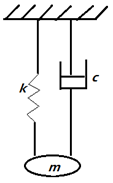This set of Mechanical Vibrations Multiple Choice Questions & Answers (MCQs) focuses on “Vibration Analysis Procedure”.
1. Which of the following method is used to derive the equation of motion of a vibratory system?
a) Rayleigh’ s method
b) Summation method
c) Finite element method
d) Approximation method
View Answer
Explanation: Rayleigh’ s method, Energy method, Equilibrium method are the methods used in analysis of vibrations to derive the equation of motion.
2. Equilibrium method states that
a) The Algebraic sum of the forces and moments acting on the system must be zero
b) The Algebraic sum of the forces and moments acting on the system must be non zero
c) The total energy of vibrating system must be equal to maximum potential energy
d) The total energy of vibrations system must be equal to minimum potential energy
View Answer
Explanation: Equilibrium method is used in analysis of vibratory system to describe the equation of motion. If sum of all the forces and moments acting on the system is zero, then we have to approach to equilibrium method.
3. which of the following term indicates the damping force in the equation mx”+cx’+kx = F ?
a) mx”
b) cx’
c) kx
d) F
View Answer
Explanation: For the equilibrium method, If the external force acting on the system is F, damping force cx’, inertia force mx”, spring force kx, then the equation of motion can be written as mx”+cx’+kx = F.
4. Mathematical modeling is essential to study the analysis of vibrations
a) Yes
b) No
View Answer
Explanation: Mathematical modeling gives the behavior of all basic component of vibratory systems to derive the mathematical equation. So, It is very essential to study the analysis of vibrations.
5. Which is the correct sequence for vibration analysis ?
a) Derivation of Governing Equations, Mathematical Modeling, Interpretation of Results, Solution to the Governing equation
b) Interpretation of Results, Solution to the Governing Equation, Derivation of Governing Equation, Mathematical Modeling
c) Mathematical Modeling, Interpretation of Results, Solution to the Governing Equation, Derivation of Governing Equation
d) Mathematical Modeling, Derivation of Governing Equation, Solution to the Governing Equation, Interpretation of Results
View Answer
Explanation: Mathematical modeling is the first step to start the procedure of vibration analysis as it gives the basic behavior of all components. Based on mathematical modeling one can derive the governing equation to describe the vibrations of system. After that solution for governing equation is obtained and final results are made.
6. The basic procedure for mathematical modeling is
a) Assumptions, Problem Identification, Geometric Constraints, Constitutive Equations, Diagrams, Mathematical Solution, Interpretation of Mathematical Results, Basic laws of nature
b) Diagrams, Geometric Constraints, Problem Identification, Assumption, Basic laws of nature, Constitutive Equation, Mathematical Solution, Interpretation of Mathematical Results
c) Geometric Constraints, Assumption, Constitutive Equation, Basic laws of nature, Mathematical Solution, Interpretation of Mathematical Results, Problem Identification, Diagrams
d) Problem Identification, Assumption, Basic laws of nature, Constitutive Equations, Geometric Constraints, Diagrams, Mathematical Solution, Interpretation of Mathematical Results
View Answer
Explanation: A solution of an engineering problem requires mathematical modeling of a physical system. The modeling procedure is same for all engineering disciplines. Option d is the correct procedure for modeling.
7. which of the following term indicates the inertia force in the equation mx”+cx’+kx = F ?
a) mx”
b) cx’
c) kx
d) F
View Answer
Explanation: For the equilibrium method, If the external force acting on the system is F, damping force cx’, inertia force mx”, spring force kx, then the equation of motion can be written as mx”+cx’+kx = F.
8. The sum of energies associated with system is constant in Energy Method
a) True
b) False
View Answer
Explanation: The sum of kinetic energy and potential energy is constant in Energy Method. It helps to find the equation of motion in vibration analysis.
9. A vibrating system basically consists of ——– elements
a) One
b) Two
c) Three
d) Four
View Answer
Explanation: A vibrating system consists of three basic elements namely the mass, the spring and damper.
10. For the following diagram, the energy stored by spring in the form of————

a) Kinetic Energy
b) Potential Energy
c) No energy stored
d) Heat Energy
View Answer
Explanation: When the excitation disturbs the mass from mean position, exchange of energy happens in vibrating system. Energy stored by the spring in the form of potential energy is converted in kinetic energy.
Sanfoundry Global Education & Learning Series – Mechanical Vibrations.
To practice all areas of Mechanical Vibrations, here is complete set of Multiple Choice Questions and Answers.
If you find a mistake in question / option / answer, kindly take a screenshot and email to [email protected]
